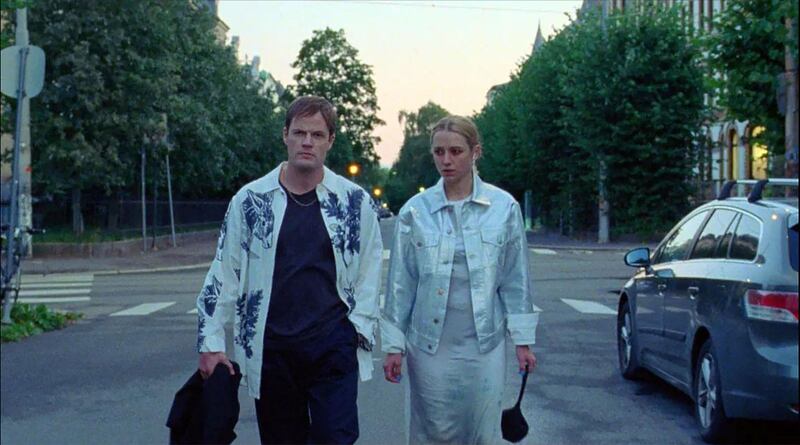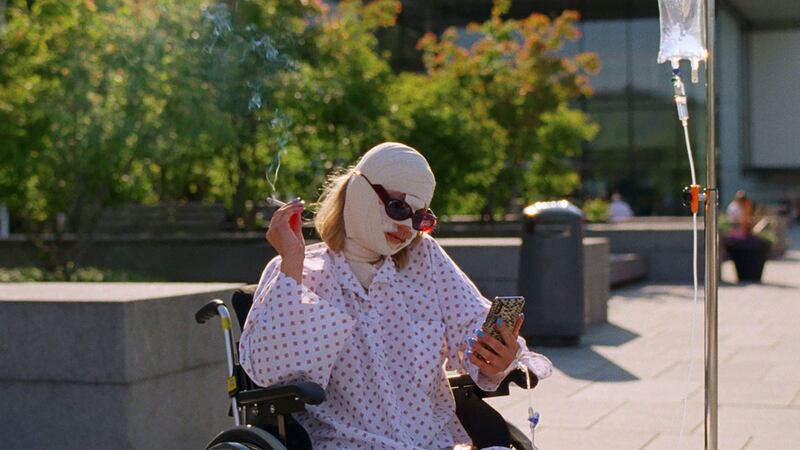The couple at the center of Sick of Myself, a blistering Norwegian comedy that opens in select theaters April 12, likes to play a game.
Say they're at a fancy dinner. Thomas (Eirik Sæther) is there to celebrate his hip new art exhibit, and Signe (Kristine Kujath Thorp) is burdened with making small talk among the guests who have gathered to honor his show. The night is all about Thomas, so Signe fakes a nut allergy and pretends to pass out in the middle of her boyfriend’s toast. Everyone’s attention diverts back to her. Mission complete.
This game has a few, shall we say, problems. Signe and Thomas sometimes don't even realize they’re playing it, and a relationship built on constant one-upmanship can’t be reasonable. Moreover, if someone is so determined to monopolize the limelight wherever they go, how far will that gluttony take them? In Sick of Myself, it takes Thomas and especially Signe to unholy extremes that look passingly familiar to anyone acquainted with the contours of modern life. The ultimate goal is to become famous, or infamous, or the star of every room—which provides ample opportunities to self-victimize if it means scoring social points.
Signe wants to be all of those things. She embellishes anecdotes to sound heroic, asks Thomas to describe her funeral during sex, and feels disappointed when a server at a restaurant doesn't realize she’s stolen a $2,300 bottle of wine. As Thomas’ art success grows, Signe can barely stand it. So she asks her drug dealer to track down a Russian pharmaceutical known to cause a ghastly rash guaranteed to make sure no one who sees her can look away. Call it millennial Munchausen’s.

Writer and director Kristoffer Borgli conceptualized Sick of Myself with a clear idea of his protagonist: “a cute, blond, privileged white girl in Oslo who had a terrible skin disease” that she’d knowingly inflicted upon herself. The image bounced around Borgli’s head for a while, taking shape in 2016 when he noticed two phenomena.
First, social media had allowed anyone to brand themselves the way traditional celebrities would, accruing clout, money, or both in the process. Second, the fashion industry’s sudden bid for inclusivity had taken hold, elevating bodies and faces that weren’t as thin or blemish-free. He decided Signe’s medical condition would catch the eye of a vulturous modeling agency interested in commodifying her warped appearance. She’d have an economic incentive to maintain the ruse—and an obvious path to fame. More pills means more magazine covers and more excuses for people to admire her supposed resilience.
“I wanted to start with a Woody Allen-esque relationship movie about an eccentric couple that suddenly takes really dark turns and becomes body horror,” Borgli tells The Daily Beast’s Obsessed. “One of the great reliefs of literature or movies to me has been to see behavior or thoughts that are worse than my own. I love that feeling when I’m like, ‘Well, I’m not that bad.’ It’s kind of like the moral canary in the coal mine.”
Calling Sick of Myself body horror might be misleading. Lest you think Signe's journey puts her in David Cronenberg territory, the movie remains an uproarious satire from start to finish. But its humor does turn a bit demented, and the whole thing can leave you feeling spiritually bereft, whether you see yourself in Signe or think she is merely mirroring the grifters and try-hards who work to command viral recognition. If nothing else, you probably know a Signe. They’re everywhere these days.
Many who have seen the movie, which premiered at last year’s Cannes Film Festival, have joked that it's too bad the title The Worst Person in the World was already taken. The protagonist in that particular Norwegian hit was hardly the worst, but Singe could be. Sick of Myself doesn’t share Worst Person’s romantic spirit, but the two films do have some overlap beyond their interchangeable names. Anders Danielsen Lie cameos as a doctor who tells Signe some hard truths, and Worst Person director Joachim Trier gave Borgli feedback while he was editing.
Together, the movies illustrate Norway’s growing film industry. John Waters recently included Sick of Myself on his annual list of favorite movies, where he called it “just as nuts” as Female Trouble, another pitch-black comedy about fame, drugs, and the beauty industry.

Part of what makes Sick of Myself so effective is its lack of pathology. “Even though she doesn’t really understand it, she’s really, really broken inside,” Kujath Thorp says. “I think it’s a very sad character, and I felt a lot of sympathy for her.” We get slivers of backstory, yet there’s no pat psychoanalysis to explain the roots of Signe’s narcissism. Kujath Thorp, who portrays her as airlessly confident, filled in some of Signe’s biography for herself, and she sent Borgli video diaries in which she improvised in character. Certain tidbits that Kujath Thorp came up with made it into the script, like insisting she’d be “extremely valuable in alleviating a terror situation.”
Still, exactly how Signe and Thomas become so malicious isn’t spelled out. Borgli says Kujath Thorp and Sæther asked many questions about why Signe and Thomas are together. He didn’t always have an answer, which feels more true to life than it might sound.
“My response was always, ‘Because it’s funny,’” Borgli says. “They’re the only ones at this point that would accept each other. That’s the way they’re bonded: ‘We’re equally horrible, and that’s why we can live together.’ Their eccentricities aren’t showing up in their little solipsistic bubble. It’s just white noise to them, this competitiveness.”
Keep obsessing! Sign up for the Daily Beast’s Obsessed newsletter and follow us on Facebook, Twitter, Instagram and TikTok.






